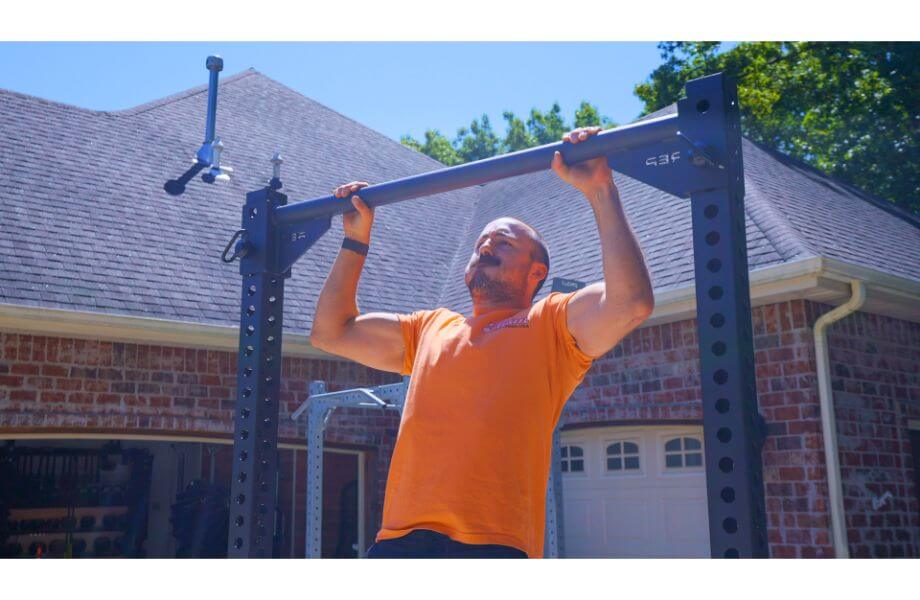We test and review fitness products based on an independent, multi-point methodology. If you use our links to purchase something, we may earn a commission. Read our disclosures.
There seems to be an overwhelming consensus among fitness enthusiasts that bodyweight exercises are worthless or too easy. Not only is this pretentious (and elitist), it’s also factually untrue. I could show you the mass of scientific literature supporting bodyweight strength training as a bonafide workout routine, or I could just talk about pull-ups.
The latter is what I’m doing here. I don’t need scientific studies to prove to you that pull-ups are hard—all I need is a video of myself attempting a five-rep set, which inevitably ends in some thrashing and grunting.
Whether you’re looking to achieve your very first pull-up or string together a set of 10, it may be useful to know the answer to the question, “What muscles do pull-ups work?” Here’s your complete guide from a certified personal trainer and functional training specialist.
Key Takeaways
- Pull-ups work over 20 muscles in your body.
- The main muscles that pull-ups work are your lats and biceps, alongside many other upper-body muscles and your core.
- Some benefits of pull-ups include increased grip strength, muscular endurance, and increased strength in the core and the upper body.
Related: Best Pull-Up Bars in 2023
Defining The Pull-Up
There are many ways to do a pull-up. For the purpose of this guide, a pull-up is a bodyweight pulling exercise performed with an overhand grip, and a rep is complete when your chin surpasses the height of the pull-up bar.
We’re not talking about CrossFit pull-ups (kipping pull-ups), underhand-grip pull-ups (chin-ups), or any variation of advanced calisthenic pull-ups; just the good ol’ standard pull-up.
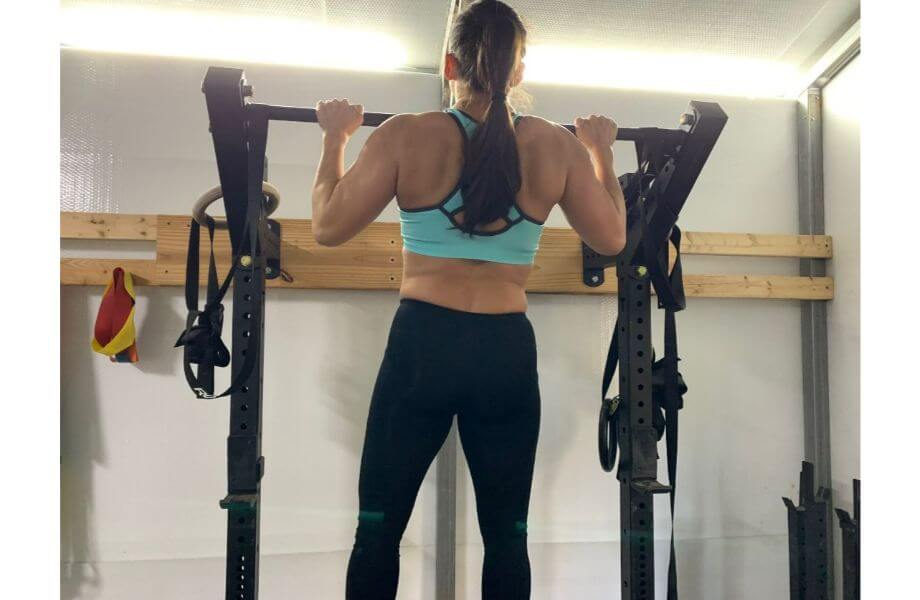
What Muscles Do Pull-Ups Work?
Pull-ups work a lot—and I mean a LOT— of muscles. Here’s the lowdown on pulling up.
Prime Movers
The prime movers in the pull-up are your latissimus dorsi and your biceps. These muscles produce the most force in the movement. You may hear others say that only the lats alone are the prime movers, but my rationale is that if you hang from a pull-up bar and contract just your lats without bending your arms, you aren’t going anywhere.
- Latissimus dorsi: The latissimus dorsi, colloquially referred to as the “lats,” are the largest, most powerful pulling muscles in the back. These large muscles run from your upper ribs all the way to the top of the pelvis and are primarily responsible for the upward motion in a pull-up.
- Biceps: Your lats aren’t able to complete the pull-up on their own. In fact, you won’t move much at all without your arms. The biceps contract as you pull your body upward and extend as you lower your body during each rep.
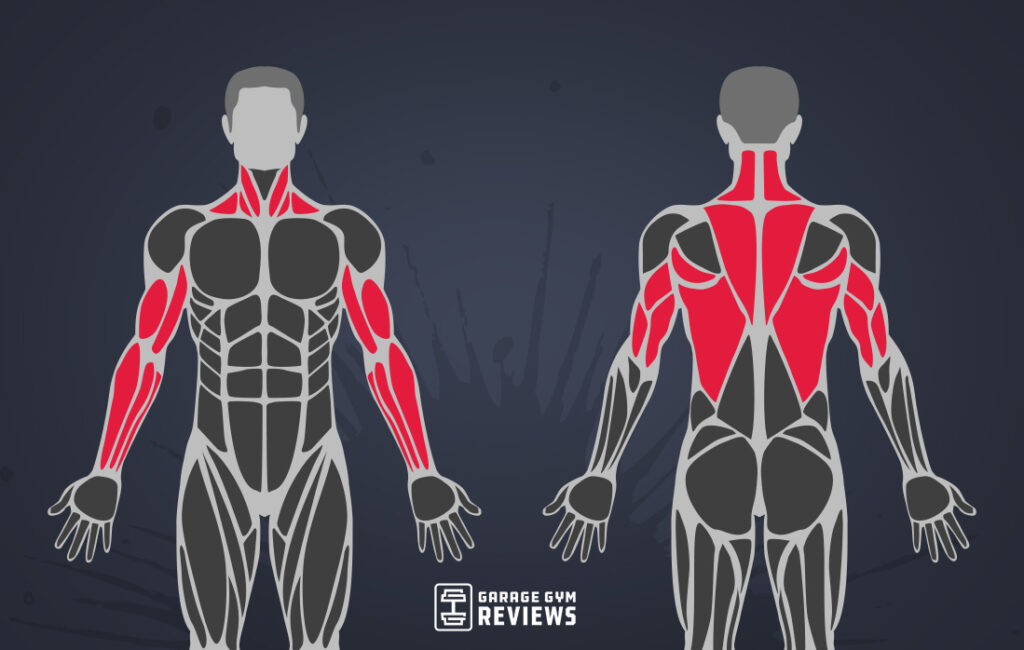
Secondary Movers
Secondary movers in the pull-up make up a large group of upper-body and core muscles. These muscles directly assist with the pulling motion.
- Rhomboids: The rhomboids (major and minor) are responsible for both shrugging the shoulder blades up and drawing them down. In the case of a pull-up, the rhomboids assist in the ascent and descent.
- Trapezius muscles: Your “traps” function similarly to the rhomboids in that they can both lift and depress the shoulder blades. During pull-ups, the trapezius muscles mostly help with stabilization of the scapulae (shoulder blades), especially at the end range of the rep and during the descent.
- Pectoralis major: You may not think outright that your pecs are involved in pull-ups, but think of how, on a hike, you may have to pull and hoist yourself up onto a ledge. Your pecs work in conjunction with the lats and other synergists during that movement pattern, and the same is true during pull-ups.
- Posterior deltoids: Again, delts typically aren’t the first muscle people think of when wondering which muscles pull-ups work. However, they help with posture during the pull and descent, as well as the “squeeze” at the top of the rep.
- Serratus anterior: This muscle runs from your first to eighth rib on each side of the torso. During pull-ups, it acts as an upward rotator of the shoulder blades. When these muscles are weak, lifting your arms above your head and moving is tough at best and painful at worst.
- Teres major: The teres major has been nicknamed the “lat’s little helper” due to its function as a shoulder blade mover.
- Upper arm muscles: Muscles responsible for flexing and extending the elbow, including triceps, brachialis, and brachioradialis, all play a role in the ascent and descent of the pull-ups, assisting the biceps brachii.
Tertiary Movers or Supporting Muscles
Supporting muscles in the pull-up are responsible for isometric contraction throughout the entirety of the movement, as well as for control on the descent. They include:
- Erector spinae: This deep back muscle contracts throughout the entire duration of a pull-up.
- Triceps: You may not think about your triceps when doing a pull-up, but they play a role in the descent. Without them, you’d find it much harder to lower your body with control.
- Supraspinatus and infraspinatus: Parts of the rotator cuff, these muscles stabilize the shoulder joint.
- Anterior deltoids: While not as important to the pull-up as the posterior deltoid, the anterior deltoid (front of the shoulder muscle) is a synergist in the movement.
- Pectorals: The pectoralis minor play a similar role as the anterior deltoids.
- Interior and exterior obliques: These muscles are largely responsible for prevention of rotation while in mid-air during pull-ups.
- The rest of the core musculature: Without core engagement, your spine would hyperextend during pull-ups.
- Levator scapulae: This muscle is responsible for vertical movement of the shoulder blades; during pull-ups, it assists with a controlled descent.
- All of the forearm muscles: Some would argue that the forearm muscles are secondary movers in the pull-up, but since their contraction is largely isometric, I’ve listed them as supporting muscles.
- Cervical muscles: The muscles in your neck may not be top-of-mind when repping out pull-ups, but they do engage.
- Teres minor: Another part of the rotator cuff, the teres minor facilitates shoulder external rotation and assists in other shoulder movements.
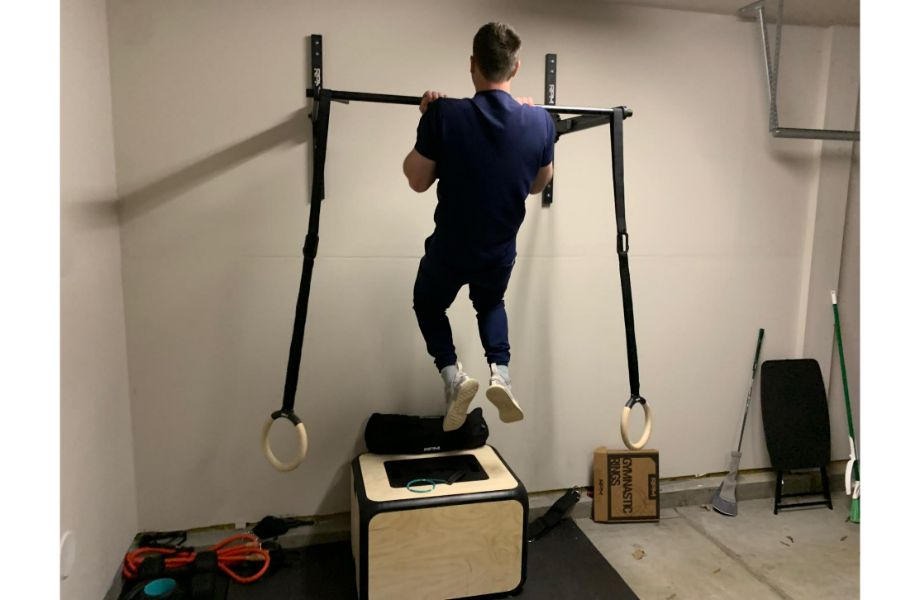
There are more small, deep muscles than covered here that, in some way or form, also engage during pull-ups.
Some experts argue that even the lower body plays a role in successful pull-up repetitions. For example, in a perfect pull-up, the glutes, hamstrings, and quads will be engaged to prevent flailing and kicking. In this sense, pull-ups aren’t just a compound exercise, but one that works the entire body.
The primary muscles worked change slightly among different pull-up variations. For example, chin-ups (pull-ups with a supinated or underhand grip), place more emphasis on the biceps. However, regardless of whether you’re doing neutral-grip, wide-grip, supinated, or pronated pull-ups, you can expect all of the above muscles to engage.
Benefits of Pull-Ups
The benefits of pull-ups are many. By regularly implementing this exercise into your routine, you’ll notice hypertrophy (muscle growth) in the back and arms, greater upper-body strength, improved core strength, increased grip strength, and muscular endurance.
Who Should Do Pull-Ups?
In short, everyone; even beginners and even very advanced, sport-specific exercisers who think pull-ups aren’t applicable to their sport. You should know that pull-ups are applicable to everything.
You’re a runner? Pull-ups will help you retain good posture and proper running form when you get tired.
You’re a weightlifter? Pull-ups will assist you in stabilizing your midline during your lifts and in receiving positions under a heavy barbell.
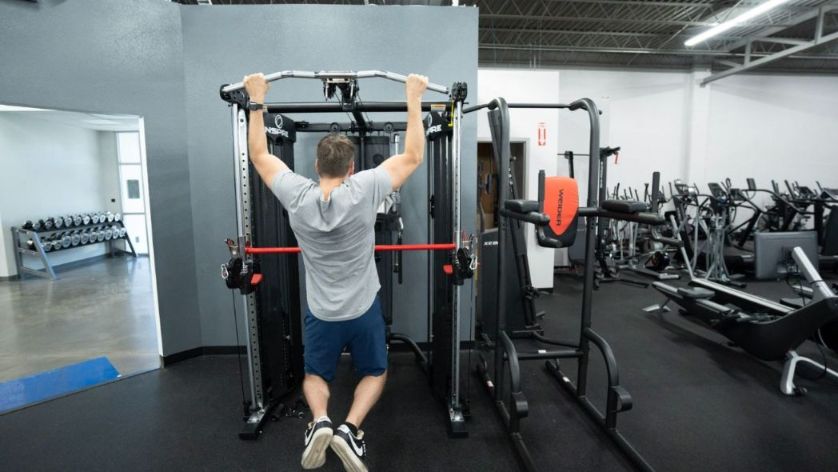
You’re a powerlifter? Pull-ups will increase your ability to hold onto a max-effort deadlift and maintain midline stability in the big three (squat, deadlift, bench press).
You’re an ultra-runner, hiker, or climber? Pull-ups will make it easier to travel with heavy packs and scramble anywhere and everywhere.
You just want to get fit to increase your quality of life, solve chronic pain, play with your kids, or make daily activities easier? Pull-ups will assist in all of those goals.
The bottom line is that pull-ups can and will benefit everyone.
Who Shouldn’t Do Pull-Ups?
I know I just said that pull-ups can and will benefit everyone, but I’d be remiss to to mention that people with certain injuries should avoid pull-ups until they’re cleared by a doctor or physical therapist to perform them.
Any variety of upper-body injuries may preclude you from doing pull-ups, particularly shoulder injuries. If you have or have had any of the following, you’d be wise to speak with a physical therapist before attempting pull-ups, lest you aggravate the pain or worsen an existing injury:
- Rotator cuff tear
- Tendinitis anywhere in the upper body
- Dislocation of the shoulder, elbow, or wrist
- Sprains (ligament tears)
- Strains (muscle tears)
- Instability of the shoulder
- Shoulder impingement
- Bursitis in any upper extremity
- Tennis elbow
- Golfer’s elbow
What Muscles Do Pull-Ups Work? Final Thoughts
Pull-ups are one of the most effective and beneficial upper-body exercises to ever exist. The pull-up works the majority of the upper-body muscles as well as the core muscles, and can help with a multitude of fitness goals, from sport-specific athleticism to everyday activities.
- The prime movers in the pull-up are the latissimus dorsi (lats), which are the most powerful pulling muscles in your back, along with the biceps.
- Secondary movers include the rhomboid major and rhomboid minor, trapezius muscles, posterior deltoids, serratus muscles (posterior, superior, and anterior), teres minor, and teres major.
- Tertiary movers or supporting muscles include the erector spinae, triceps, anterior deltoids, pecs, interior and exterior obliques, the rest of the core musculature, levator scapulae, all of the forearm muscles, supraspinatus, and cervical muscles found in the neck.
Basically: When you perform a pull-up, every muscle from the hips up is working in one way or another, whether it’s directly responsible for pulling, isometrically contracting to stabilize the midline, or responsible for maintaining control on the descent.
What Muscles Do Pull-Ups Work? FAQs
What muscles do pull-ups work?
Pull-ups work over 20 muscles in your body, and the primary muscles involved are the lats and biceps. Pull-ups may also challenge the rhomboids, trapezius, serratus anterior, and other muscles that provide assistance to stabilize your body.
Can you build muscle with just pull-ups?
Yes, pull-ups can certainly help you build muscle. Doing pull-ups can support muscle growth in the back, shoulders, and core. The most noticeable hypertrophic effects of pull-ups are a broader back and bigger biceps.
Are pull-ups or chin-ups better?
Both exercises are great to perform and challenge the lats and biceps, so the best fit for you depends on your goals. With chin-ups, you’ll feel your biceps working a bit more due to the hand positioning, and many find them to be easier than traditional pull-ups. Pull-ups emphasize the back more than the biceps, but may be more difficult.
Do pull-ups work biceps or triceps?
Pull-ups primarily work the lats and biceps. The primary function of the triceps is to extend the elbow and straighten the arm, but since you’re hanging from a bar, gravity takes care of this, and your triceps don’t need to do any work to straighten your arm.
The biceps are worked during pulling exercises, like pull-ups, chin-ups, and rows, while the triceps are worked during pushing exercises, like bench presses, shoulder presses, or push-ups.
References
- Cedric X. Bryant (Editor), Sabrena Newton-Merrill (Editor), Daniel J. Green (Editor). The Exercise Professional’s Guide to Personal Training. 5th edition. American Council on Exercise; 2014.
- ACE’s Essentials of Exercise Science for Fitness Professionals. 4th edition. American Council on Exercise; 2010.
- OrthoInfo. Rotator Cuff Tears. American Academy of Orthopaedic Surgeons.
- MedlinePlus. Tendinitis. National Library of Medicine.
- OrthoInfo. Chronic Shoulder Instability and Dislocation. American Academy of Orthopaedic Surgeons.
- OrthoInfo. Shoulder Impingement/Rotator Cuff Tendinitis. American Academy of Orthopaedic Surgeons.
- MedlinePlus. Bursitis. National Library of Medicine.
- OrthoInfo. Tennis Elbow (Lateral Epicondylitis). American Academy of Orthopaedic Surgeons.
- Kiel J, Kaiser K. Golfers Elbow. [Updated 2022 Jun 27]. In: StatPearls [Internet]. Treasure Island (FL): StatPearls Publishing; 2022 Jan-. Available from: https://www.ncbi.nlm.nih.gov/books/NBK519000/
Further reading

Looking for the best exercise bike for your home gym? We give our thoughts on the different types, and who should buy which. Read more

In our Genius Pre-Workout Review, a nutrition coach breaks down the ingredients and supplement facts. Read more

Not sure which treadmill to get for your home gym? This manual vs electric treadmill comparison should help clear things up. Read more

Tired of your worn-out treadmill eating up space in your home or garage? Get tips on how to dispose of a treadmill with safety and the environment in mind. Read more

